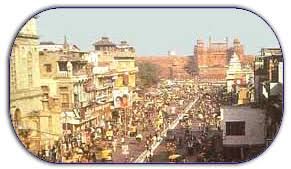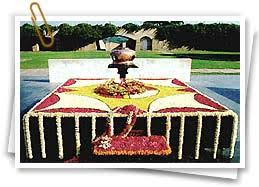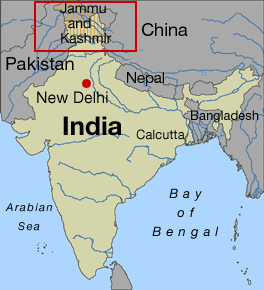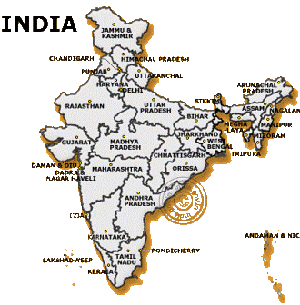INDIAN FOOD
Very fine meals that suit the various taste buds of people all over the world are prepared in India. Strict vegetarianism is mostly confined to the South. Beef, from the holy cow is strictly taboo for the Hindus and Pork is equally taboo for the Muslims.
In the north, much meat is eaten and cooking is often of the "Mughal style" which bears relation to that of the Middle East and central Asia. The emphasis is more on spices and less on curry heat. In the north more grains and breads are eaten and less rice. In the South, more rice is eaten and the curries tend to be hotter. Another peculiarity of Southern vegetarian food is that it has to be eaten by hand and not by fork and spoons!
Curry and Spices
There is no such thing as "curry" in India. It is an all-purpose term devised by the English to cover the whole range of Indian food spicing. Indian cooks have about 25 spices on their regular list and it is from these that they produce curry flavor. Normally the spices are freshly ground in a mortar and pestle called SIL_VATTA. Spices are usually blended in certain combinations to produce meals. Garam Masala, for example is a red-hot combination of cloves and cinnamon with peppercorns.
Popular spices include saffron, an expensive flavoring produced from flowers. This is used to give biryani, that yellow color and delicate fragrance. Turmeric also has a coloring property and acts as a preservative. Chillies are ground, dried or added whole to give that hot taste to curries. They come in red and green varieties but the green ones are the hottest. Ginger is supposed to be good for digestion. Coriander is added to many masalas so as to cool the body. Cardamom is used in many sweet dishes and in meat preparations. Other popular spices are nutmeg, cinnamon, poppy seeds, caraway seeds, cumin seeds, fenugreek, mace, garlic and cloves.
Breads
Rice is the staple food of the Indians but it is given much importance only in the South. The best Indian rice is the famous Indian Basmati whose patenting has raised a lot of dust and is still under controversy. It is predominantly grown in the Dehra Dun Valley. It has long grains, is yellowish in color and has a slight sweetish or "bas" smell, which gives it its name.
In the north a range of breads called ROTIS or PHULKA in Punjab supplements this rice. Indian breads are varied but they are always delicious. Simplest form is the Chapatti, just Wheat flour and water fried up like a thin pancake. It is supposed to be a British invention. Rotis are flour and water cooked on a hot tawa. Direct heat blows them up, but how well depends on the glutin content of the wheat. Baste your roti in butter or ghee and it becomes a paratha. If deep-fried it is called poori in the north and loochi in the east, made of rice and black gram flour it is called dosa in the South. Dosas are found all over India and when wrapped around curried vegetables it becomes masala dosa, a nice snack. Another type of deep-fried bread with a stuffing is the Kachori. Bake the bread in an oven and it becomes Naan. An Idli is a kind of rice dumpling, often served with dal curry called sambar, a south Indian favorite and green chilly chutney. Tomato or Onion chutneys also go with it. Papadams are crispy deep-fried wafer often served with Thalis or other meals.
Basic Dishes
Curries can be made of vegetables, fish, meat, chicken, lamb, and pork. Mostly vegetable oils are used for this purpose. These curries are accompanied by rice in the South and Rotis in the north. Probably the most basic of Indian dishes is Dhal. Dhal is almost there everywhere whether as an accompaniment to a curry or with rice and chapattis. The favorite dhal of Bengal and Gujarat is yellow arhar; in Bengal channa is also yellow; mung is green, rajma is Heinz. Altogether there are 57 varieties of dhal available in India.
Tandoori and Biryani
Tandoori food is northern specialty and refers to the clay oven in which the food is cooked after first being marinated in a mixture of yogurts and spices. Tandoori chicken is a special favorite in many places.
This food is not very hot and usually tastes terrific. Biryani is a Mughal dish. Chicken Biryani is mostly the best favored. Here the meat is mixed with deliciously flavored, orange colored rice, which is spiced with nuts and dry-fruits. A Pulao is a simpler version of the biryani. These biryanis are not too hot like most of the curries
Regional specialties
Rogan Josh is a curried lamb popular in Kashmir where it originated and also in most parts of northern India. Guntaba, pounded and spiced meat balls cooked in a yogurt sauce is also a Kashmiri specialty. Still in the north, Chicken Mahanwala is a rich dish cooked in a butter sauce. Many coastal areas have excellent seafood, including Bombay, where the Pomfret, a flounder-like fish, is popular. Bombay Duck, another fish dish is also famous in Bombay. Dhansak is a Parsi specialty found in Bombay, lamb or chicken cooked with curried lentils and steamed rice. Goa has excellent fish and prawns. Further South in Kerala, all varieties of prawns and crabs and a lot of fish are available.
Another famous Indian dish is the Kababs. These are found all over north India with a lot of variations. The two main forms are Sikka (skewered) or Shami (wrapped). In Calcutta Kati kababs are a local favorite. Further south in Hyderabad, Hallen, pounded wheat with lightly spiced mutton gravy is available. The Andhras are noted for their heavily chillied food. In Tamilnadu Pongal made of cooking rice with jaggery is a specialty. Equally notable is the "vada", made of Black gram dhal flour or Bengal gram dhal mixed with chillies and lots of onions. These two always find their place in the menu of any Tamil family.
Side dishes
Indian food has a number of side dishes to go with the main meal. Probably, the most popular is the Dahi- or curd or yogurt. It has the ability to cool the stomach after a very hot meal. Curd is also used in making Desserts and in the popular drink Lassi. Raitha is another popular side dish where with curd a lot of vegetables in raw form or curried vegetables are mixed. Particularly tomato and cucumber is used. Sabzi are curried vegetables, bhartha is pureed or minced vegetables, and bhujjas are fresh vegetables. India is also famous for a variety of pickles. They come in all flavors, lime, mango, ginger, onion, mixed vegetables, chili, alloo, etc., and in a number of combinations of the above mentioned.
Thalis
A thali is the all-purpose Indian vegetarian dish. Although it basically belongs to south India, it is found in the north too. There are regional variations also. The name comes from the "thali" dish in which it is served. The Thali consists of a metal plate with a number of small metal bowls known as Katoris on it. Sometimes the small bowls are replaced by small indentations on the plate itself. Mostly the plate is a big Banana leaf.
A thali consists of a variety of vegetable curry dishes, relishes, a couple of papadams, puris or chapattis and a whole lot of rice. A deluxe variety would include a Pata, a rolled betel leaf stuffed with fruit and nuts. It may also include curd and one or two Desserts. The main plus points of thalis are they are cheap and 100% filling. Moreover the rice is unlimited for the Gourmet.
Snacks
Samosa, tasty little curried vegetable snacks fried up in a pastry triangle, are found all over India. Bhelpuri is a popular snack in most of the cities, one, which is sold in peddled, carts in the nights. Chana, spiced chick peas served with puris is also a roadside favorite. Chat, a general term for snacks and nibbles is now found in good packs to suit all tongues and pockets.
Western Food
The western foods available for breakfast include Bread Toast and Jam, Bread with butter or Cheese, all types of egg like omelette, fried eggs, bulls-eye and a lot more, the types that can be prepared with little effort. One western food that the Indians have come to terms 100% is the French Fries, which we Indians call, the chips. Calcutta and Bombay have a small Chinese population so Chinese foods can be had in the major cities with a little search. In the north where the Tibetans have settled in many places Tibetan restaurants are present as in places like Dharamsala, Manali and Srinagar.
Desserts and Sweets
Indians are said to have a sweet tooth and an amazing collection of sweets are available to satisfy them. Kulfi is a widely acceptable dessert, a sort of Indian representation of ice cream. Of course, good quality ice creams are also available from a number of leading brands all over the country. Rasgullas are another popular type of Dessert, sweet little balls of rose-flavored cream cheese.
Desserts are mainly rice or milk puddings in sweet syrup or sweet pastries. Gulab Jamuns are small round balls made of flour, yogurt and ground almonds. Jalebi are pancakes in syrup. Milk dishes are usually boiled until the liquid has been removed and then the various ingredients are added to desserts like barfi, which has coconut with almond or pistachio flavoring. Sandesh is a variety of milk dish popular in Calcutta. Payasam as it is called in the south is made from milk simmered with crushed cashews, cereals and sugar, topped with raisins. Firnee is a rice pudding dessert with almonds, raisins and pistachios.
Many of the Indian sweets come with a coating of silver paper, which is edible. Halwa, a translucent, vividly colored sweet belongs to Tamilnadu, particularly the Tirunelveli District. Grinding wheat for a long time and then boiling the ground paste with sugar and seasoned with a lot of nuts makes it.
Fruits
India boasts of a wide variety of fruits, fresh from the gardens. The collection varies all the way from tropical delights in the south to apples, apricots and other temperate region fruits in the north. Cherries and strawberries are available aplenty in Kashmir, and apricots in Ladakh and Himachal Pradesh. Apples are found all over the northwestern part but particularly in the Kulu Valley of Himachal.
Melons are widespread in India, particularly watermelons that are fine thirst quenchers. Mangoes and bananas are found in many parts of India; Pineapples in Assam, Oranges in Kerala, tangerines are widespread in Central India, particularly the hot season.
Paan
An Indian meal finishes with Paan- the name given to the collection of spices and condiments chewed with betel leaves. Found throughout eastern Asia, Betel is mildly intoxicating and addictive. But after a meal it is taken as a mild digestive in small amounts. Paan sellers have a number of little trays and containers in which they mix either sadha or Mitha (sweet) paans. The ingredient may include apart from the betel nut itself, lime paste, various spices and even a dash of opium for a better price. The whole concoction is folded up cleverly and chewed.
Drinks Non - Alcoholic
Tea is the most popular drink in the north, while in the south, coffee is the number one drink. "Tray Tea", which gives you the tea, milk and sugar separately is the most commonly available form of tea in most of the sophisticated hotels in India. Nimbu Paani, which is nothing but lemon squash is commonly available in all the towns, particularly in the summer. A number of branded soft drinks like Pepsi, Coca-cola, sprite, seven-up, etc have cropped up in recent times, and they seem to quench ones thirst though they are said to have only artificial contents with high sugar content. Apple juice drinks are widely available in Himachal Pradesh. Coconut milk, straight from the young coconut, is a popular street-side drink. Another escape from soft drinks is the plain soda, which is widely available. Finally there is the Lassi, that cool, refreshing and delicious iced curd drink. 
Drinks - Alcoholic
Alcohol seems to be little expensive in India. In some states like Goa, it is very cheap, whereas in some states like Tamilnadu, it is very expensive. Indian Beers to mention are Golden Eagle, Rosy Pelican, Cannon Extra Strong, Kingfisher, etc., Beer and other interpretations of western alcoholic drinks are known as Indian Made Foreign Liquor (IMFL). Local drinks are called country Liquor and include Toddy, a mildly alcoholic extract from coconut palm flower, and Feni, a distilled liquor produced from Fermented cashew nuts or from coconuts. The two varieties taste differently.











































